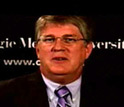News Release 10-124
Green Bank Telescope Enables "Intensity Mapping" to Shed Light on Mysteries of Dark Energy
Carnegie Mellon researcher Jeff Peterson describes new technique developed by international research team to expand understanding of the expanding universe

The Robert C. Byrd Green Bank Telescope is the world's largest, fully steerable radio telescope.
July 21, 2010
View video soundbites of Jeff Peterson of Carnegie Mellon University.
This material is available primarily for archival purposes. Telephone numbers or other contact information may be out of date; please see current contact information at media contacts.
Using the world's largest, fully steerable radio telescope--the National Science Foundation's Robert C. Byrd Green Bank Telescope (GBT) in W.Va.--an international team of researchers has given astronomers the promise of a new tool for mapping the universe and gaining valuable clues about the nature of the mysterious "dark energy" believed to constitute nearly three-fourths of the universe's mass and energy. "Intensity Mapping" offers the potential for significant contributions to the field and further discovery. This research is detailed in the July 22 issue of the journal Nature.
In the matter-energy soup of the extremely early universe, sound waves are thought to have left detectable imprints on the large-scale distribution of galaxies. The researchers developed a way to measure such imprints by observing the radio emission of hydrogen gas. Their technique, called intensity mapping, when applied to greater areas of the universe, could reveal how such a large-scale structure has changed over the last few billion years, giving insight into which theory of dark energy is the most accurate.
This new technique was developed by an international collaborative team that consists of Tzu-Ching Chang, of the Academia Sinica in Taiwan and the University of Toronto, Ue-Li Pen of the University of Toronto, and Jeffrey Peterson and Kevin Bandura of Carnegie Mellon University (CMU).
The National Radio Astronomy Observatory (NRAO) Chief Scientist Chris Carilli, who was not part of the research team, commented on the research in the News and Views section of Nature's July 22 issue in a piece titled, "Broad-brush Cosmos: An innovative way of mapping the large-scale structure in the universe sidesteps the need to observe millions of gallaxies individually. The approach holds promise for both astroyphysical and cosmological studies."
"This is a demonstration of an important technique that has great promise for future studies of the evolution of large-scale structure in the Universe," said Carilli.
The researchers used the GBT to study a region of sky that previously had been surveyed in detail in visible light by the Keck II telescope in Hawaii. This optical survey used spectroscopy to map the locations of thousands of galaxies in three dimensions. Instead of looking for hydrogen gas in these individual, distant galaxies--a daunting challenge beyond the technical capabilities of current instruments--the team used the GBT to find and map the hydrogen gas in many galaxies at once. This gave them a picture of the "cosmic web" of large-scale structure.
To address inherent observational challenges, the astronomers developed new techniques that removed both man-made radio interference and radio emission from more-nearby astronomical sources, to leave the extremely faint radio waves coming from the very distant hydrogen gas. The result was a map of part of the "cosmic web" that correlated neatly with the structure shown by the earlier optical study.
Bandura, a CMU graduate student and beneficiary of the NRAO student support program for observing on the GBT, stayed up all night and collected the data. NSF funds the NRAO, operated under a cooperative agreement by Associated Universities, Inc.
-NSF-
-
View Video
Jeff Peterson of CMU in video soundbites describes a new astronomical survey tool.
Credit and Larger Version
Media Contacts
Lisa-Joy Zgorski, NSF, (703) 292-8311, email: lisajoy@nsf.gov
Jocelyn Duffy, Carnegie Melon University, (412) 268-9982, email: jhduffy@andrew.cmu.edu
Dave Finley, National Radio Astronomy Observatory, (575) 835-7302, email: dfinley@nrao.edu
Program Contacts
Vernon L. Pankonin, NSF, (703) 292-4902, email: vpankoni@nsf.gov
Principal Investigators
Jeff Peterson, Carnegie Melon University, (412) 478-1918, email: jbp@cmu.edu
Related Websites
Radio Astronomers Develop New Technique for Studying Dark Energy: http://www.nrao.edu/pr/2010/highzhi/
Carnegie Mellon Researchers Unveil New Study of Management Of Solar Radiation: http://www.cmu.edu/news/index.shtml
Eyes on the Sky: NSF Astronomy From the Ground Up: http://www.nsf.gov/eyesonthesky
National Radio Astronomy Observatory, Robert C. Byrd Green Bank Telescope: http://www.gb.nrao.edu/
The U.S. National Science Foundation propels the nation forward by advancing fundamental research in all fields of science and engineering. NSF supports research and people by providing facilities, instruments and funding to support their ingenuity and sustain the U.S. as a global leader in research and innovation. With a fiscal year 2023 budget of $9.5 billion, NSF funds reach all 50 states through grants to nearly 2,000 colleges, universities and institutions. Each year, NSF receives more than 40,000 competitive proposals and makes about 11,000 new awards. Those awards include support for cooperative research with industry, Arctic and Antarctic research and operations, and U.S. participation in international scientific efforts.
Connect with us online
NSF website: nsf.gov
NSF News: nsf.gov/news
For News Media: nsf.gov/news/newsroom
Statistics: nsf.gov/statistics/
Awards database: nsf.gov/awardsearch/
Follow us on social
Twitter: twitter.com/NSF
Facebook: facebook.com/US.NSF
Instagram: instagram.com/nsfgov

